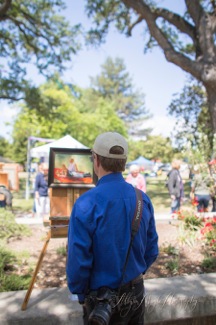Artist and art industry veteran Terry Stanley explains that winning an art competition hinges on doing one thing right at the onset: entering properly. This is not a given, Stanley explains.
by Terry Stanley
In a perfect world, everyone would see every work of art with the artist’s own eyes. The reality is, all you can do is maximize your chances by making sure technicalities don’t put your entry in the “denied” pile without the work itself being considered.
Read the prospectus! Size restrictions, deadlines, etc., are all important, and it’s up to YOU, not the organizers to make sure you follow them.
Information requested on the entry form is not optional. Make sure it’s legible. If you have the penmanship of a drunken chimp, get a friend to write it for you.
Visit the gallery or organization’s website for past shows and see if your work is a good fit. If you do abstracts made from glue and cake mix (yes, that was real) and enter it in a competition that focuses on hyperrealism in oil, you are wasting your entry fee.
Learn how to enter the PleinAir Salon here – the next deadline is coming soon!
The vast majority of competitions have gone digital. File-naming conventions (the way the competition wants the entry image labeled) MUST be correct. Most places won’t take the time to rename files and will reject them instead.
When you take images of your artwork, please follow the basic tenets (these are particularly important if you don’t know how to fix perspective or crop in your photo editing program):
– Photograph only the artwork, not the frame, the wall it’s hanging on, or your cat sitting next to it.
– Do not try to take photos of a painting that is under glass. I’m sure I’ve passed by some great work because I couldn’t accurately assess the art thanks to reflections.
– Make sure your camera lens is parallel to the image and aimed at the center of the artwork.
– Make sure the artwork is evenly lit. If you don’t have color-correct bulbs, outdoor indirect sunlight is your best bet.
– Do NOT alter the image! You may (if you know how) make minor-level adjustments to accurately show the colors, but adding to, subtracting from, or altering your image is not kosher. I actually sent a couple of paintings back over the years because it was painfully obvious when they arrived at the gallery that the artists had made huge changes in their digital images to make the work look better. The paintings themselves were NOT acceptable.

– Prepare your image to the specifications. If you don’t know the difference between dpi, ppi or inches or don’t know a .jpg from a .png, seek out a friend who does. You can’t just change the numbers in your photo editing resolution box from 72 to 300. It doesn’t work like that. Again, only a few very friendly curators will bother walking you through the process. There are lots of great places to get information on the Internet, and video tutorials are available for every photo-editing software program.
For in-gallery exhibits, respect your work enough to present it professionally. The frame should be well made and properly wired, and complement the work. The most memorable framing fail I can remember uncrating was a really lovely painting that had been “framed” by gluing veneer edging around the outside of the canvas … and the glue had seeped out from under the veneer and onto the painting surface. It had a high four-figure price tag. The artist had a fit when I called to let him know I was returning it as unfit to show.
If you have to ship your work, use an Air-Float or similar box meant to take a beating during its journey. They’re expensive, but can be used multiple times. FedEx has some affordable new art shippers that work great for un-glazed work (I haven’t tried it for anything with glass). Packing peanuts are universally detested. A dozen layers of plastic and bubble wrap won’t win you any friends at the gallery either.
Lastly, if your work isn’t accepted or you don’t get an award, please do not call the organizers or jurors and cuss them out. This happens way more often than you’d expect. I guarantee the curators and jurors are doing their best to put out the best show possible from the field of entries they receive. All you can do is make sure your work has a fair shot at inclusion by following the rules and providing the best image possible to be considered.
PleinAir magazine presents the 12th annual PleinAir Salon $33,000 Art Competition. In the spirit of the French Salon created by the Academie des Beaux-Arts in Paris, this annual online competition, with 11 monthly cycles, leading to the annual Salon Grand Prize winners, is designed to stimulate artistic growth through competition. The competition rewards artists with over $33,000 in cash prizes and exposure of their work, with the winning painting featured on the cover of PleinAir magazine.
Winners in each monthly competition may receive recognition and exposure through PleinAir magazine’s print magazine, e-newsletters, websites, and social media. Winners of each competition will also be entered into the annual competition. The 12th Annual Awards will be presented live at the Plein Air Convention & Expo in May 2023.





I think you mean your camera lens should be *perpendicular* to the artwork, not parallel, yes?
Not really Shelli.